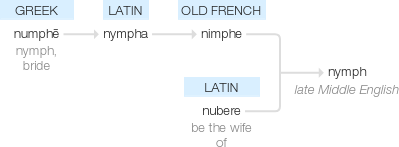Nymph
late Middle English: from Old French nimphe, from Latin nympha, from Greek numphē ‘nymph, bride’; related to Latin nubere ‘be the wife of’.
wiktionary
From Middle English nimphe, from French nimphe, from Latin nympha(“nymph, bride”), from Ancient Greek νύμφη(númphē, “bride”). Doublet of nympha.
etymonline
nymph (n.)
late 14c., nimphe, "one of a class of semi-divine female beings in classical mythology," imagined as beautiful maidens, eternally young, from Old French nimphe (13c.) and directly from Latin nympha "nymph, demi-goddess; bride, mistress, young woman," from Greek nymphē "bride, young wife," later "beautiful young woman," then "semi-divine being in the form of a beautiful maiden;" usually said to be related to Latin nubere "to marry, wed" (see nuptial), but Beekes suggests a Pre-Greek origin.
Sub-groups include dryads, hamadryads, naiads, nereids, and oreads. The sense in English of "young and attractive woman" is attested from 1580s. Meaning "insect stage between larva and adult" is recorded from 1570s. Related: Nymphal; nymphean.
